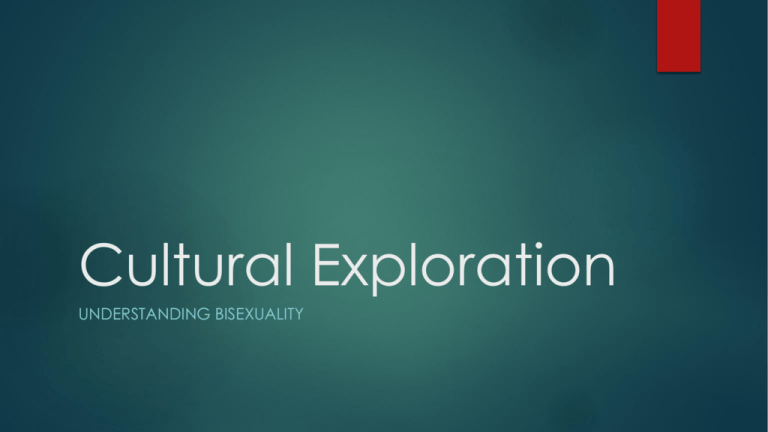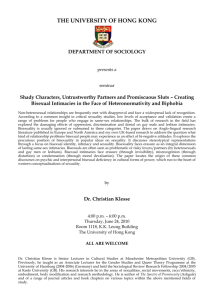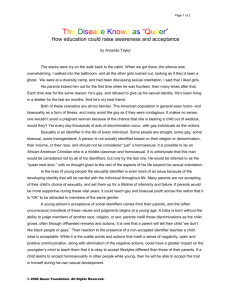Cultural Plunge Presentation - Offical Blog of Scott David Brown
advertisement

Cultural Exploration UNDERSTANDING BISEXUALITY Definition of Sexual Orientation The American Psychological Association (2011) describes sexual orientation as the sex that a person is attracted to. This includes attraction to the same sex, opposite sex, or both (APA, 2011). Yet, sexual orientation may not always fit in defined categories and it may be more fluid for some (APA, 2011). Common Classifications of Sexual Orientations* • • • • Heterosexuality – Being attracted to members of the opposite sex. Often “straight” is assumed unless otherwise corrected. Homosexuality – Being attracted to members of the same sex. Less accepted, but slowly becoming more so with younger generations. Gay people still face prejudice and unacceptance in some communities. Bisexuality – Being attracted to both genders. Probably the most misunderstood sexual orientation. Bisexuals are often mistaken for being gay or confused. Pansexuality – Having interest in many or all classifications of gender or sex (King, 2011). Sometimes used instead of the “bisexual” label (King, 2011). *It is important to note that some people do not identify with any sexual orientation. Common Myths These myths are based on what this author has learned from this cultural plunge: • It seems that many people assume that bisexuals are unable to form monogamous relationships. This is true in some cases, as is true with people who are strait or gay. However, it is probable that bisexuals are no more or less likely to be polyamorous than someone who is strait, gay, or none of the above. • Bisexuals are often the subject of three major stereotypes: (1) They are greedy, not being able to chose just one gender instead of sticking with one. (2) They are over-sexed or perhaps obsessed with sex. (3) Not faithful, as in unable to honor monogamous commitments. • Another assumption about bisexuals is that they are liars or deceitful. • Some believe that people who are not gay or strait suffer from confusion about their own sexual orientation. This belief assumes that there is really only two valid orientations. Of course, some claim that there is really only heterosexuality. Prejudice and Discrimination Based on Sexuality Bullying is becoming an epidemic in schools, especially bullying based on sexual orientation. This author faced insults and mistreatment based on false claims that he was gay. This can occur due to behaviors or other observations that are missidentified as homosexually linked. Even as a straight man, this author feels strongly that sexual prejudice must end. Photo of the author in his early 20s. Even with positive developments, like with gay marriage support increasing, there still is a problem with bullying in the LGBT community (Conley, 2013). The National Day of Silence is an effort to bring to the attention of the public that many youth and young adults are voiceless because they are unable to be open about their gender identity or sexual orientation due to possible negative consequences (Conley, 2013). Homosexuals have to face different experiences than heterosexuals. However, bisexuals and people who do not identify with any sexual orientation may face a special challenge: dealing with people who cannot understand attraction to more than one sex or orientation. Religion and Philosophy Even with political and social movements demanding equality and respect, people still face prejudice. Religion has been used as an excuse to discriminate based on race and sexual orientation. While it is possible that the majority of religious people do not have prejudice towards certain sexual orientations, religious doctrine generally is against relationships other than between one man and one woman. It is promising that Pope Francis has been more accepting of people of non-faith and of homosexuality. It may be signaling a change within the Catholic Church. However, Church polices are unlikely to change in the near term. Coexist Topography, by Andy-Pants (2013). The Cultural Plunge This author had little knowledge about bisexuality. He has worked with people who are gay and transsexual and had human sexuality covered in some of his psychology classes. However, most of what he knew about bisexuality was unreliable. The main reason for studying bisexuality was to gain a better understanding of it. Discussing sexuality can be a difficult task. Not everyone is comfortable with the topic. It is important to be sensitive and careful with how one approaches sexuality discussions. The internet can be helpful in this manner and provide a certain level of comfortably and anonymity that make it easier for people to talk about their own sexuality. Others are more than happy to talk about it in person as long as there is no judgment. The most important lesson was that people who are bisexual or do not identify with any particular orientation are really no different than straight or gay people. This isn’t a surprise, but there are still plenty of people who might be surprised to learn this. As already mentioned, one of the biggest myths about bisexuals is that they can’t or chose not to be monogamous. The amount of partners one desires does not seem to be the result of sexual orientation. Another thing to consider is that sexual labels may not exactly apply to every person. For example, the label of bisexuality may not fit perfectly. What if someone is mostly attracted to one gender and only occasionally attracted to the other? Is someone who is bisexual always attracted to women and men equally? There is some disagreement on the subject. That it why it is important to allow people to define themselves instead of giving a blanketed label to people. What was most interesting was that bisexuals sometimes face discrimination from homosexuals. It is logical to think that both groups could relate to each other as they have been targets of discrimination from heterosexuals. One bisexual person said she was not welcomed in a gay bar and that she has met lesbians that won’t date her because she is bisexual. This author feels that it is important to watch out for one’s own prejudice. While this author didn’t have any negative opinions of bisexuality, it is clear that he had some misconceptions. For example, he did not know that bisexuality is not as clear cut as heterosexuality or homosexuality tends to be. Nor did he realize how number of partners seems unaffected by sexual orientation. In hindsight, it seems fairly obvious. Social anxiety is a minor issue this author deals with when entering a new social environment. It’s easier now, but there were times when it took time to adjust to a new job or school. This author was a bit nervous looking for people for this project. He wasn’t sure how comfortable people would be about discussing their own sexual orientation. Now he feels more comfortable asking personal questions related to sexuality. Being diversity conscious means that a person takes steps to understand the many different individuals one encounters in life. Society is moving towards a more divers population, especially in cities, and that is why it is so important to be aware if differences. Understanding the differences between people should help one become more sensitive to differences and not allow them to lead to prejudice. That is why empathy is so important. A person who is diversity conscious can work with people from different backgrounds without creating conflicts or making offensive judgments. Discomfort from meeting new people can also be handled this way. It is understandable that a person may feel anxiety when meeting someone they know nothing about. Listening and relating to the person helps calm this anxiety. It is also helpful to do research about a group before interacting with them. Personal Philosophy on Diversity • It is important to keep an open mind when meeting new people. It is probable that one’s mind will make snap judgments. Take these judgments with a grain of salt and be ready to dismiss them. It is not always fair to base an opinion about a person on first impressions. • When working in a team environment, one should listen carefully to what their co-workers say. Learning about them can also help improve future interactions with them. • Experiencing a new culture may seem a bit scary at first, but it can also be enlightening. There could be similarities between the new culture and one’s own culture. • Do not assume that one person is a perfect representation of their culture. For example, believing all feminists hate men is prejudicial and wrong even if that perception is based on your experience. • The more one is open to diversity, the more experiences one can have. This can lead to many rewarding relationships and a better understanding of the world. • When traveling outside of one’s culture, it is important to be a good emissary. Respecting the host culture will help spread a positive reputation of one’s own culture. Bisexual Survey It would be interesting to learn more about how people come to understand their sexuality. Everyone must go through this process. Many people find it difficult to understand their own sexuality when they are young. Straight, gay, bi, or other orientations are not always easily understood. A survey sent out on Reddit’s Bisexual section came back with some interesting results: • The Label of bisexuality was not a perfect fit for most respondents. Owning the label “bisexual” is not the same as owning “strait” or “gay.” Biseuxality seems to apply to most of the respondents, but they also tend to feel that it oversimplifies things. Like already mentioned, bisexuality isn’t necessarily liking men and women 50-50. • There was mixed results with how important it was for respondents to identify with a group of people, culture, or population. Some like being part of a group, to feel like they belong to something. Others don’t feel it is important. • Most respondents reported experiencing prejudice from others who were misinformed on what bisexuality is or believed it wasn’t real. Acceptance of bisexuality varies depending on the region. • Awareness and education is important to help increase societies’ treatment towards bisexuals and people who do not prescribe to any sexual orientation. • Discrimination is something that each respondent could attest to. Much of it comes from parents with strong religious faith. Some were discriminated against in school. • Most respondents are not religious. Some call themselves atheist, agnostic, and atheist agnostic. • Most are not political, though some have specific issues they are interested in, i.e. environmental issues. • Favorite experiences that were mentioned ranged from no longer having to hide their sexual orientation to specific meaningful relationships. One mentioned matching in the Gay Pride Parade. • Misconceptions that respondents still face include: that being bisexual is just a cover for being gay, always being down for threesomes, being confused bout their sexuality, being greedy, and bisexual men aren’t real. Conclusion Learning about bisexuality has reinforced some previous beliefs. For example, sexual orientation is not confined to two or three different categories. Sexuality is complicated and like most labels, one classification does not fit everyone. The people this author has learned about are intelligent and diverse. They have to deal with issues that this author has not had to. Sexuality is something that this author struggled with many years ago. This gave him a sense of empathy and understanding. Still, there is a different kind of prejudice towards people who feel attracted to both sexes. It was discovered that this author shares values and political issues with the people mentioned in this presentation. It is not a surprise as issues like the environment and sexual education are important to many different people. Differences in values can be assumed when meeting someone new. Sometimes it is tempting to assume that a person from another culture or personal background is unrelateable. However, often it is the case that cultures share some commonalities. There are qualities that this author believes are uniquely human that transcend culture. One example is the need to live authentically and to understand one’s self. As individuals, it is possible to celebrate differences without using them to segregate people. It is important to balance the need for individuality while also supporting collectivism. Living in a civilization requires unity and fairness. This author believes there is a responsibility to help those in need and to help support each other in building a healthy community. At the same time, personal freedom and responsibility are important. For a final thought, this author feels more comfortable with the idea of dating someone who is bisexual. He admits that it was not clear how such a relationship would work. In a way, it seems foolish to wonder if someone who is bisexual could be in a committed relationship. It is a lesson about assumptions and being open-minded. The most important lesson, perhaps, is that one should not simply stereotype people. Assuming that a group of people behave in the same way or share the same thoughts may be unfair. References American Psychological Association (2011). Definition of Terms: Sex, Gender, Gender Identity, Sexual Orientation. APA.org. Retrieved from: http://www.apa.org/pi/lgbt/resources/sexualitydefinitions.pdf Conley, L. (2013, Apr 17). Upstate groups participate in campaign to fight bullying based on sexual orientation. Spartanburg Herald - Journal. Retrieved from http://search.proquest.com/docview/1328294525 King, A. R. (2011). Environmental influences on the development of female college students who identify as Multiracial/Biracial-Bisexual/Pansexual. Journal of College Student Development, 52(4), 440-455. Retrieved from http://search.proquest.com/docview/881644205







